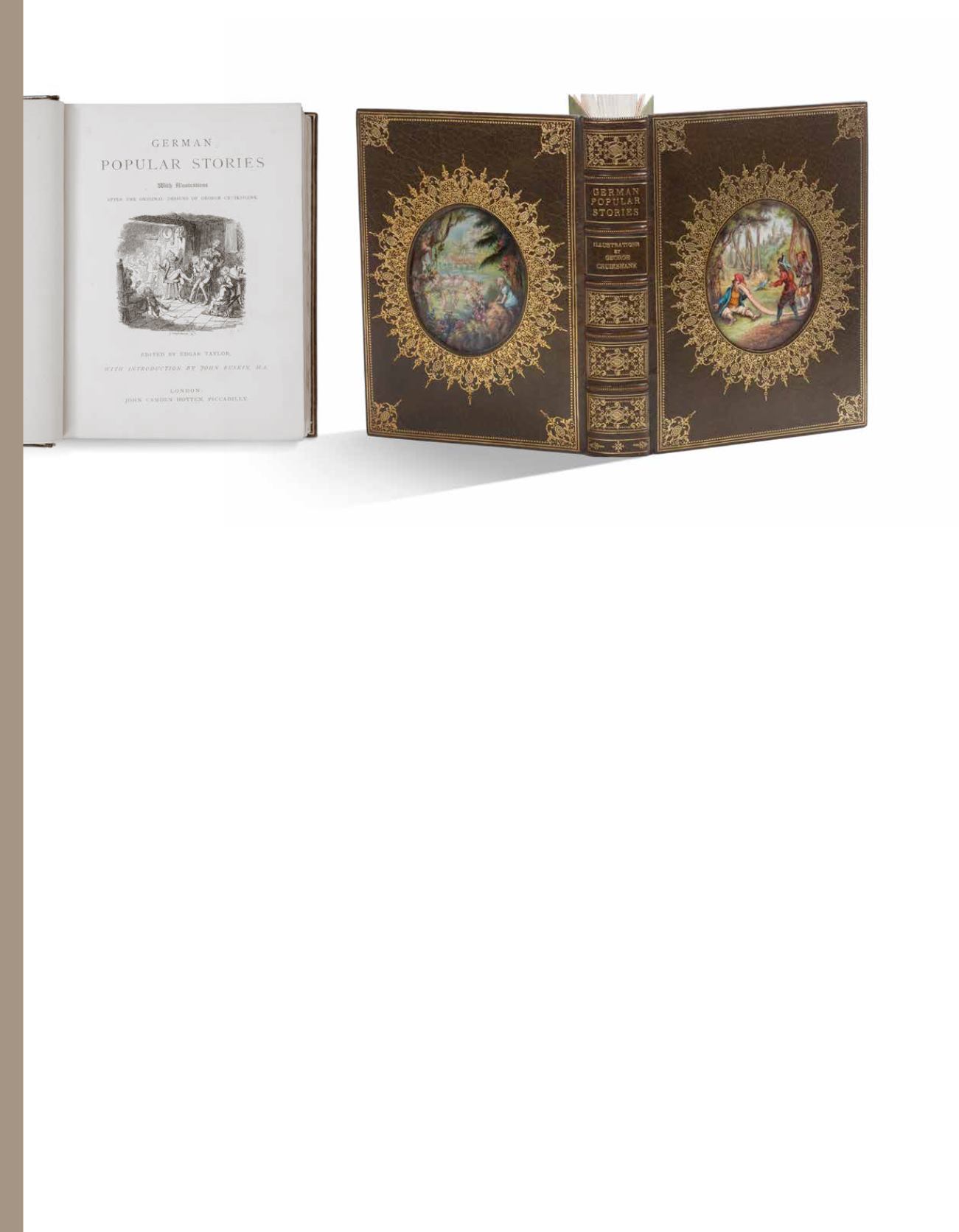

124
les collections aristophil
89
GRIMM JACOB
(1785-1863) and
WILHELM
(1786-1859).
Linguistes, philologues et collecteurs de contes allemands.
German popular stories with illustrations after the original
designs of George Cruikshank; edited by Edgar Taylor; with
an introduction by John Ruskin MA.
London : John Camden Hotten, [1869]
3 000 / 4 000 €
In-8, XXVI, 335 p., faux-titre, vignette au titre, 21 planches (eaux-fortes).
Reliure de style “Cosway” par « Rivière & Son », reliure signée sur
la doublure, plats ornés de “miniatures” aquarellées par C.B. Currie,
deux grand ovales sur chaque plats, peintes sur ivoire. Plein maroquin
olive, dos à 5 nerfs fleuronné et doré, double filet en encadrement
sur les plats double d’une ligne de petits point dorés, fers dorés aux
coins des encadrements, miniatures serties dans de grandes frises
ornées et dorées composées de petit fers, tête dorée, frise dorée
intérieure, doublures et premiers feuillets de garde de soie vert olive,
estampille dorée « Miniatures by C.B. Currie », ouvrage conservé
dans une boite articulée de toile verte. Dimensions: 190 x 142 mm
Traduction anglaise des Contes des frères Grimm, traduits par Edgar
TAYLOR (1793-1839) avec des illustrations de George CRUIKSHANK
(1792-1878).
GRIMM JACOB
(1785-1863)
AND WILHELM
(1786-1859).
German popular stories with illustrations after the original
designs of George Cruikshank; edited by Edgar Taylor; with
an introduction by John Ruskin MA.
London : John Camden Hotten, n.d. [1869]
3 000 / 4 000 €
In-8, XXVI, 335 p., half-title, title vignette, 21 plates (etchings). Bound
in a Cosway binding with two large oval miniatures, one on each
cover, of scenes from the stories painted on ivory by C. B. Currie.
Olive crushed morocco, double-fillet border with a parallel dotted
line and gilt-stamped leaf tools at four corners, a frame of the same
leaf tools and gold dots surround the miniatures, top edge gilt, gilt-
tooled turn-ins, olive watered-silk doublures and endleaves, by Rivière
& Son, stamp-signed in gilt “Miniatures by C.B. Currie,” in a green
cloth drop-box. Dimensions: 190 x 142 mm.
An English translation of the Grimm Brother’s tales.
This book of
German Popular Stories
is the first English translation of
a selection of fairytales collected by the brothers Jacob and Wilhelm
Grimm. The two volumes of Kinder und Haus Märchen – literally
‘Children’s and Household Tales’ – were first published in Germany
in 1812–15. The uncredited translator of the stories was Edgar TAYLOR
(1793-1839), a lawyer and author who spoke German, Italian, Spanish
and French. He collaborated with another German speaker, his friend
David Jardine, and in the introduction they express the hope that
publishing these stories will entertain young and old alike, and help
to end the regrettable neglect of the ‘popular tales of England’ as well.
The first edition was published in 1823. The translation was immediately
successful and did much to make fairy tales an acceptable form of
reading material for children in the 19th century. Taylor’s intention that
children should enjoy the tales accounts both for his choice of stories
– he omitted those containing particularly gruesome passages – and
for some of the alterations made in his translation. For example, in a
number of the tales he replaced the devil with a giant.
The stories are illustrated by George CRUIKSHANK (1792-1878), and
the frontispiece vividly depicts the storyteller reading aloud to a
group of avid listeners. The early German editions of the tales were
not illustrated, but the use of Cruikshank’s pictures in the English
translation set the pattern for future fairy tales.
In 1869, thirty years after Taylor’s death, Taylor’s widow granted the
publisher John Camden Hotten permission to combine the first two
editions of German Popular Stories into one book with the original
prefaces by Taylor, and introduction by the famous critic John
Ruskin, a letter endorsing the book by Sir Walter Scott, and a new
advertisement. This is the first edition in which Taylor’s name as
a translator appeared on the title page.
















